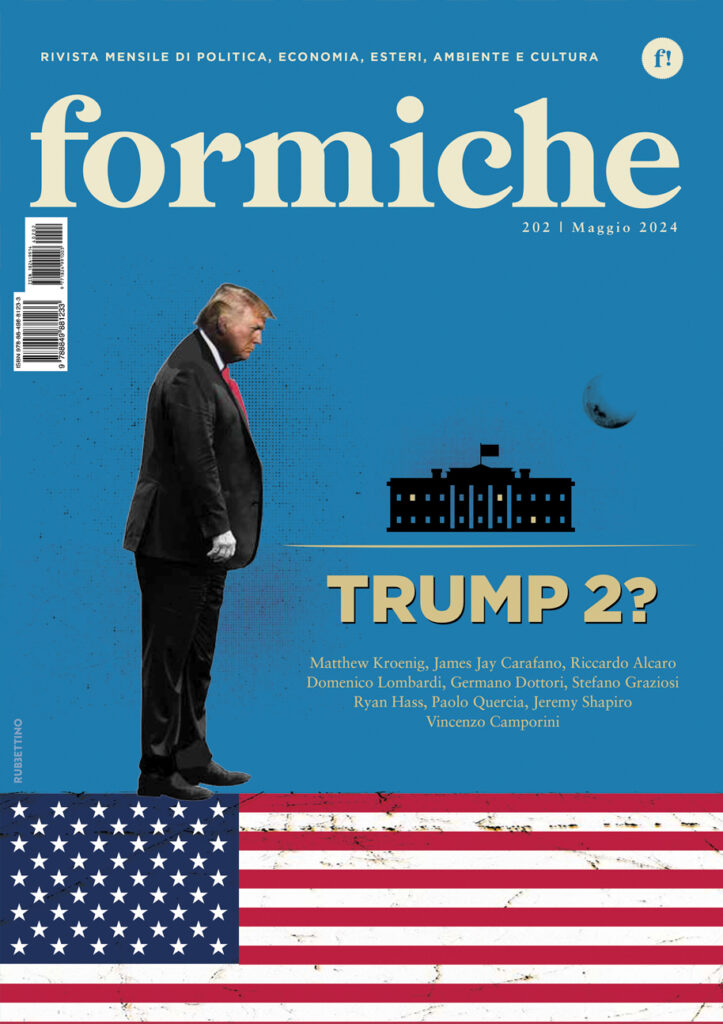Quarant’anni fa, quando sono entrato all’Università di Oxford per una specializzazione post-laurea, dichiarai di essere interessato al Medio Oriente. Mi si disse allora che questa parte del mondo era studiata nel programma “Studi orientali”, e che mi sarebbe stato assegnato un professore specializzato. Ma quando andai al mio primo incontro con quel professore, nel suo studio notai una pila di volumi scritti in caratteri cinesi. Risultò che, almeno per me in quel momento, egli era specialista nell’oriente sbagliato. In un analogo errore è incorsa, in un certo senso, la politica estera americana. Gli Stati Uniti si sono interessati al Medio Oriente – per così dire, “l’oriente sbagliato” – e non hanno dedicato sufficiente attenzione all’Asia orientale e al Pacifico, dove verrà scritta in gran parte la storia del XXI secolo.
La buona notizia è che questo focus sta cambiando. Una vera e propria trasformazione silenziosa sta interessando la politica estera Usa, una trasformazione che è tanto significativa quanto da tempo dovuta. L’America ha riscoperto l’Asia. “Riscoperto” è la parola chiave in questo caso. L’Asia è stato uno dei due principali teatri della Seconda guerra mondiale, e ancora durante la Guerra fredda aveva in comune con l’Europa una posizione centrale. Infatti i due più grandi conflitti militari del periodo – la guerra in Corea e in Vietnam – sono stati combattuti sul continente asiatico.
Ma con la fine della Guerra fredda e il crollo dell’Unione sovietica, l’Asia si è allontanata dai radar americani. Nella prima decade dell’era post-Guerra fredda, gli Stati Uniti hanno diretto gran parte della loro attenzione all’Europa. Gli strateghi della politica Usa erano concentrati soprattutto sull’allargamento della Nato in modo da inglobare molti dei Paesi dell’ex Patto di Varsavia, e sui modi per controllare i conflitti nell’ex Jugoslavia. La seconda fase dell’era post-Guerra fredda è cominciata con gli attacchi terroristici dell’11 settembre, cui è seguito un decennio di impegno americano contro il terrorismo, con il dispiegamento su vasta scala di truppe in Iraq ed Afghanistan. I due conflitti hanno causato oltre 6mila morti americani, con un costo di oltre 1 trilione di dollari, consumando infinite ore del lavoro di due presidenti e del loro staff di esperti. Ora questa fase della politica estera americana si sta chiudendo. Barack Obama ha deciso il ritiro dall’Iraq alla fine dell’anno scorso.
In Afghanistan, i livelli di impiego delle truppe americane hanno raggiunto l’apice e stanno declinando: l’unica questione aperta è il ritmo del ritiro e la dimensione e il ruolo di una residua presenza militare statunitense dopo il 2014. Ciò non significa che il Medio Oriente sia irrilevante o che gli Stati Uniti dovrebbero ignorarlo. Al contrario, è ancora il luogo in cui si concentrano immense riserve di petrolio e gas. È una parte del mondo in cui sono attive organizzazioni terroristiche e i conflitti sono stati numerosi. L’Iran si sta attrezzando in gran fretta per poter disporre di armi nucleari; se ci riuscirà, altri potranno seguire rapidamente il suo esempio. Inoltre, è una regione in cui si sta realizzando un sollevamento sociale che potrebbe avere portata storica. E infine, c’è il legame speciale tra Usa e Israele.
Tuttavia ci sono motivi per considerare l’ipotesi di un minore attivismo americano nel “più grande Medio Oriente” oggi, rispetto a ieri: l’indebolimento di al Qaeda, le scarse prospettive di pace israelo-palestinese, e soprattutto, la prova sempre più evidente che, secondo ogni misura, l’enorme sforzo di nation-building applicato all’area non sta portando a ritorni commisurati agli investimenti fatti.
Al tempo stesso ci sono forti argomenti per sostenere un maggiore coinvolgimento Usa nella regione Asia-Pacifico. Con la sua immensa popolazione ed economie in rapida crescita, la regione ha un rilievo economico che è difficile esagerare. Le imprese americane vi esportano ogni anno beni e servizi per oltre 300 miliardi di dollari. Al tempo stesso, le nazioni asiatiche sono una fonte di investimento di importanza critica per l’economia Usa. Mantenere la stabilità regionale è perciò cruciale per la prosperità economica americana (e globale). Gli Stati Uniti hanno obbligazioni derivanti da alleanze multiple con Giappone, Corea del Sud, Australia, Filippine e Thailandia. In parte, esse servono come deterrente rispetto a un’aggressione nordcoreana. Inoltre, gli Stati Uniti devono creare un ambiente in cui una Cina emergente non sia tentata di usare la sua crescente potenza in modo coercitivo all’interno o all’esterno della regione. In questo senso è ben motivato il recente impegno americano a rafforzare i legami con l’India e con parecchi Paesi del sud-est asiatico.
Gli Stati Uniti fanno bene a spostare l’attenzione dal Medio all’estremo Oriente. La buona notizia è che questa conclusione sembra condivisa da tutte le forze politiche nazionali. Mitt Romney si è impegnato ad incrementare l’attività cantieristica, segnalando così l’intenzione di aumentare la presenza americana nel Pacifico. E la segretaria di Stato Hillary Clinton parla dell’abbandono del ruolo guida americano nel “più grande Medio Oriente”, poiché “il centro di gravità strategico ed economico del pianeta si sta spostando ad est, e noi dobbiamo concentrarci maggiormente sulla regione Asia-Pacifico”.
Non sappiamo se il Ventunesimo secolo sarà un altro secolo americano; certo sarà un secolo asiatico e pacifico. È naturale, e al tempo stesso saggio, che gli Stati Uniti si posizionino al centro rispetto ad ogni possibile evoluzione derivante da questo fatto.
© Project Syndicate 2011. Traduzione di Marco Andrea Ciaccia
Il testo in inglese
Some 40 years ago, when I entered Oxford University as a graduate student, I declared my interest in the Middle East. I was told that this part of the world came under the rubric of “Oriental Studies,” and that I would be assigned an appropriate professor. But when I arrived for my first meeting at the professor’s office, his bookshelves were lined with volumes bearing Chinese characters. He was a specialist in what was, at least for me at the time, the wrong Orient.
Something akin to this mistake has befallen American foreign policy. The United States has become preoccupied with the Middle East – in certain ways, the wrong Orient – and has not paid adequate attention to East Asia and the Pacific, where much of the twenty-first century’s history will be written.
The good news is that this focus is shifting. Indeed, a quiet transformation is taking place in American foreign policy, one that is as significant as it is overdue. The US has rediscovered Asia.
“Rediscovered” is the operative word here. Asia was one of the two principal theaters of World War II, and again shared centrality with Europe during the Cold War. Indeed, the period’s two greatest conflicts – the wars in Korea and Vietnam – were fought on the Asian mainland.
But, with the end of the Cold War and the demise of the Soviet Union, Asia receded from American interest. In the first decade of the post-Cold War era, the US trained much of its attention on Europe. American policymakers focused primarily on enlarging NATO to encompass many of the former Warsaw Pact countries, and on contending with the post-Yugoslav wars.
The second phase of the post-Cold War era began with the 9/11 terror attacks. What followed was a decade of US focus on terrorism and the large-scale commitment of American military forces to Iraq and Afghanistan. The two conflicts have claimed more than 6,000 American lives, cost more than $1 trillion, and consumed countless hours for two presidents and their senior staff.
But now this phase of American foreign policy is ending. President Barack Obama has announced that US armed forces will be out of Iraq by the end of 2011. In Afghanistan, US force levels have peaked and are declining; the only questions concern the pace of withdrawal and the size and role of any residual US military presence after 2014.
This is not to argue that the Middle East is irrelevant or that the US should ignore it. On the contrary, it is still home to massive oil and gas reserves. It is a part of the world where terrorists are active and conflicts have been common. Iran is moving ever closer to developing nuclear weapons; if it does, others may well follow suit. And it is a region now experiencing what could prove to be historic domestic political upheavals. There is also the unique American tie to Israel.
Nevertheless, there are grounds for the US doing less in the greater Middle East than it has in recent years: the weakening of al-Qaeda; the poor prospects for peacemaking efforts; and, above all, the mounting evidence that, by any measure, massive nation-building initiatives are not yielding returns commensurate with the investments.
At the same time, there are strong arguments for greater US involvement in the Asia-Pacific region. With its large populations and fast-growing economies, it is difficult to exaggerate the region’s economic importance. American companies export more than $300 billion in goods and services to countries in the region each year. Meanwhile, Asian countries are a critical source of investment for the US economy.
Maintaining regional stability is thus critical for US (and global) economic success. The US has multiple alliance obligations – with Japan, South Korea, Australia, the Philippines, and Thailand – which are needed, in part, to deter North Korean aggression. Moreover, US policy must create an environment in which a rising China is never tempted to use its growing power coercively – within or outside the region. For this reason, recent US efforts to strengthen ties with India and several Southeast Asian countries make good sense.
The US is right to shift its focus from the Middle East to the Far East. The good news is that this conclusion seems to be shared across the US political spectrum. Mitt Romney, the likely Republican nominee for president, pledges to increase the rate of shipbuilding – a commitment linked to an increased US presence in the Pacific. And US Secretary of State Hillary Clinton speaks of America pivoting away from the greater Middle East: “The world’s strategic and economic center of gravity is shifting east, and we are focusing more on the Asia-Pacific region.”
Regardless of whether the twenty-first century will be another “American century,” it is certain that it will be an Asian and Pacific century. It is both natural and sensible that the US be central to whatever evolves from that fact.







